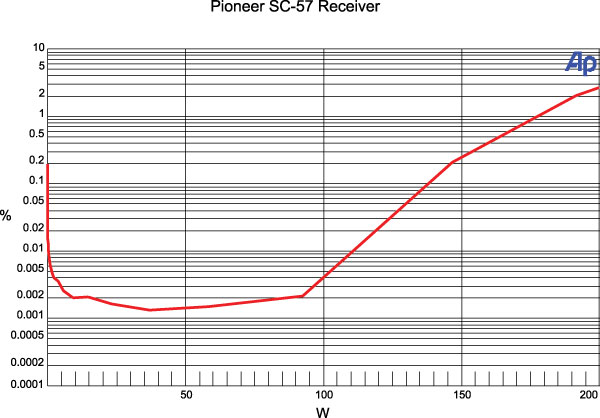Pioneer Elite SC-57 A/V Receiver HT Labs Measures
Five channels driven continuously into 8-ohm loads:
0.1% distortion at 115.1 watts
1% distortion at 132.0 watts
Seven channels driven continuously into 8-ohm loads:
0.1% distortion at 109.6 watts
1% distortion at 123.7 watts
Analog frequency response in Pure Direct mode:
–0.25 dB at 10 Hz
–0.07 dB at 20 Hz
+1.00 dB at 20 kHz
–1.21 dB at 50 kHz
Analog frequency response with stereo signal processing:
–0.95 dB at 10 Hz
–0.29 dB at 20 Hz
–1.23 dB at 20 kHz
–68.57 dB at 50 kHz

This graph shows that the SC-57’s left channel, from CD input to speaker output with two channels driving 8-ohm loads, reaches 0.1 percent distortion at 138.1 watts and 1 percent distor- tion at 178.0 watts. Into 4 ohms, the amplifier reaches 0.1 percent distor- tion at 215.7 watts and 1 percent distortion at 254.2 watts.
Response from the multichannel input to the speaker output measures –0.25 decibels at 10 hertz, –0.07 dB at 20 Hz, +0.94 dB at 20 kilohertz, and –1.21 dB at 50 kHz. THD+N from the CD input to the speaker output was less than 0.006 percent at 1 kHz when driving 2.83 volts into an 8-ohm load. Crosstalk at 1 kHz driving 2.83 volts into an 8-ohm load was –82.52 dB left to right and –82.90 dB right to left. The signal-to-noise ratio with an 8-ohm load from 10 Hz to 24 kHz with “A” weighting was –104.71 dBrA.
From the Dolby Digital input to the loudspeaker output, the left channel measures –0.04 dB at 20 Hz and –0.51 dB at 20 kHz. The center channel measures –0.03 dB at 20 Hz and –1.36 dB at 20 kHz, and the left sur- round channel measures –0.01 dB at 20 Hz and –1.40 dB at 20 kHz. From the Dolby Digital input to the line-level output, the LFE channel is –0.00 dB at 20 Hz when referenced to the level at 40 Hz and reaches the upper 3-dB down point at 118 Hz and the upper 6-dB down point at 121 Hz.—MJP
Video Test Bench
The Pioneer sailed through all but a few of our video tests. It displayed minor artifacts in the 2:2 SD tests, both digital and analog. It also failed the analog Chroma Resolution test, exhibiting rolloff at the highest burst frequency.

FYI for new readers: All of the digital tests are done from an HDMI input to the AVR’s HDMI output. The clipping test (which includes checking for both above white and below black) and resolution tests (luma and chroma) are performed 1080p in to 1080p out. The 3:2 HD, 2:2 HD, and MA (Motion Adaptive) HD digital tests are 1080i in to 1080p out. The digital SD tests are 480i in to 1080p out apart from the Scaling test, which is 480p in to 1080p out.
The analog tests are similar, except that they are performed from a component input to an HDMI output—that is, they test for an AVR’s upconversion capability. In the analog tests, Video Clipping and Resolution are checked with a 1080i input. Consumer sources, including Blu-ray players, will not output component at 1080p. We do not test component in to component out.
In fact, newer disc players will not upconvert standard-definition material to 720p or 1080i/p at their component outputs. Next year’s disc players, and other sources as well, will eliminate component video outputs altogether.—TJN





























































